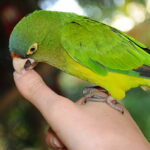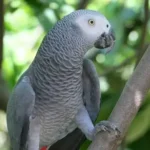The African grey parrot (Psittacus erithacus) has the distinction of being one of the finest mimics in nature. These popular and long-lived pets are traded and kept in captivity all over the world. Many of us have seen and interacted with these incredibly intelligent birds in a captive setting. Still, there is another side to these animals that many people may not be aware of.
African greys are native to forests and savanna woodland habitats in equatorial Africa. They occur from Guinea in the west to Kenya in the East. They are social birds in nature that forage for fruits, seeds, and bulbs in flocks of up to 30 individuals. There are three accepted subspecies of African grey parrots, although the timneh parrot (P. e. timneh or P. timneh) is also regarded by many sources as a full species.
African grey parrots have an estimated average lifespan of 22.7 years in their natural environment. They are very long-lived in captivity, potentially surviving for 40-60 years with good care. The oldest African grey parrot we know of was an amazing 55-year-old when it died.
African grey parrots face many threats in the wild, including predators, habitat destruction, hunting, and illegal trapping. African greys make intelligent and long-lived pets, although they can be affected by many infectious and non-infectious diseases.
How Long Do African Grey Parrots Live?
African grey parrots can live remarkably long in captivity with the right care. These birds can reach impressive ages of between 40 and 60 years, which means they frequently outlive their carers. Careful thought should go into adopting a young African grey parrot for just this reason.
In captivity, African grey parrots can live for a long time with the right care.
How long do African greys live in the wild?

The genus Psittacus (African grey parrots) once contained a single species (Psittacus erithacus) as well as a subspecies (Psittacus erithacus timneh). Nowadays, the subspecies has been elevated to the status of an actual species: Psittacus timneh, also known as the Timneh African grey parrot.
There are some subtle but noticeable differences between the two African grey species, and they don’t occur in the same areas in the wild. However, their potential lifespans seem pretty much the same.
Wild African grey parrots can reach impressive ages. As is to be expected, though, a large percentage of them don’t even make it to adulthood. The life of an African grey in its natural habitat can be harsh, with threats from disease as well as raptors and other predators.
The average lifespan of an African grey parrot in the wild was concluded in a 2002 study to be 22.7 years (Ryan, 2002), which is not bad at all considering the dangers they face on a daily basis.
What are the predators of African greys?
African grey parrots are vulnerable to predation at every stage of their lifecycle. Palm-nut vultures and other raptors are the most significant predators of nesting African greys, but squirrels and humans are also enemies.
Carnivorous mammals, birds of prey, and larger reptiles like pythons are also likely to hunt adult African grey parrots. Humans also trap and hunt adult African greys, both for sale in the pet trade and for food and medicinal purposes.
What is the lifespan of an African grey parrot in captivity?

As pets, African grey parrots are very intelligent and lovable. These birds are also good as pets because of their long lifespan. They can live up to many years if taken good care of. However, the life span depends on various factors. The life span is important because every owner wants a long-lived mate as their pet.
The African grey parrots’ average lifespan as pets is 45 to 50 years. Their average lifespan in the wild is 40 to 60 years. Though, like pets, the lifespan of these birds may fluctuate as per their surroundings. They can live more than the average age estimated if they get proper maintenance and suitable habitat.
Sometimes, the birds living as pets are likely to survive more years than they do in the wild. The reason is they are safe from dangers and predators at home. Although African greys are very smart birds to escape dangers, the chances of fleeing from hazards frequently are difficult. So, the average African grey parrot’s lifespan is long and varies depending on some factors. If these factors can be endured, then the lifespan of African grey parrots can be increased.
How can you tell the age of an African grey?
Knowing when an adult African grey parrot was born is the only truly reliable way of knowing its age. It is possible to estimate the age of birds that are about five years or younger by looking at their eye color, however.
African grey parrots have black irises until the age of about four months. By the age of approximately one year, the eyes will have lightened to a gray color. At the age of approximately two years, most African greys will have straw-colored eyes, and by four years, the iris should have become the characteristic light yellow color of the adults.
What is the longest-living African grey?

The oldest living African grey parrot may have been a male named Tarbu, who was born in Tanzania in 1957. This special bird lived a full 55 years before passing away in England in 2012.
The oldest recorded bird in the Psittaciforme order (Parrots, macaws, cockatoos, etc.) was a Major Mitchell’s cockatoo named Cookie. This amazing bird lived to be over 82 years old. Cookie’s lifespan provides a good indication of the potential age of captive psittacine birds, even though he was not an African grey.
How do most African greys die?
African grey parrots are still caught in the wild and traded in the exotic pet market despite new laws and trade restrictions. It is estimated that over 40% of wild-caught birds will die before being sold by the trapper. By the time they reach a trading hub, further losses mean that over 60% of the birds will have perished before being sold as pets.
Unfortunately, these intelligent birds are easily trapped and hunted in nature due to their reliance on natural salt licks. Not everyone sees these birds as companions, however. African greys are frequently consumed as ‘bush meat’ and used in traditional medicine.
In the wild, African grey parrots are vulnerable to a wide variety of predators, diseases, and extreme weather events. Chicks and eggs are vulnerable to predation, flooding, overgrowing vegetation, and collapsing or harvesting of the trees where they nest.
In captivity, African greys are susceptible to many infectious and non-infectious diseases that can be fatal. These are some of the most frequently reported health issues:
- Psittacine Beak and Feather Disease (PBFD)
- Avian bornavirus (ABV)
- Psittacosis
- Sarcocystosis
- Aspergillosis
How long can African greys live without food?
African grey parrots are said to be able to go two to four days without food, although they will feed every day under normal circumstances. Many factors will determine how long a bird can survive without food, however.
The most important factors are:
- The amount of energy the individual has in reserve
- The ambient temperature
- The health and activity level of the bird
Are African greys endangered?

African grey parrots are an endangered species. According to the International Union for Conservation of Nature (IUCN), the population is still in decline and the species is already extinct in some parts of its former range.
African greys are most threatened by collection for the pet trade. It is estimated that a staggering 21% of the population is harvested annually. This, combined with habitat destruction for forestry and agriculture, is the most important threat to the species.
As of 2016, all trade in wild African grey parrots has been banned. As a measure to prevent illegal trade, captive breeding facilities must now be registered with CITES (the Convention on International Trade in Endangered Species of Wild Fauna and Flora).
Final Thoughts:
African grey parrots are charming and elegant birds to have as pets. They are long-lived and can become an exciting friend. However, the life span varies depending upon numerous factors; still, they have a good period of life to become suitable pets.
This article helped you to understand the lifespan of an African grey parrot. Now you know the answer to, “How long do African grey parrots live as pets?”. Bring an African grey to your home and have a lovable companion for you.






























































vurcazkircazpatliycaz.IT1wGDiwzrBb
daktilogibigibi.MNE8E3lAwsz0
daxktilogibigibi.3ztCUEJHXA5f
disinformations xyandanxvurulmus.8KyLRbvtrJuX
Many people use their lotteries to improve money for precious initiatives that improve education,
public infrastructure and cultural services. When the lottery will be performed
by you, you’re assisting to fund these programs when you fund
your own wishes of succeeding it big. Have fun and good luck!